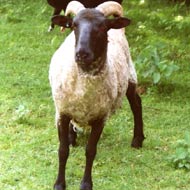Ram examination guidelines updated

The debate identified a need to bring the guidance into line with current best practice.
Guidelines for the examination of rams for breeding have been updated, following a fertility workshop organised by the Sheep Veterinary Society (SVS).
Since the previous guidelines were drawn up in 2007, the practice of fertility testing by sheep vets in the UK has changed considerably. To maintain good health plans and ensure effective breeding programmes, it is important to assess rams routinely.
Earlier this year, scientists and veterinary experts attended the workshop in Edinburgh, which was funded by SVS, Ceva Animal Health and EBLEX-AHDB, to discuss comprehensive, evidence based protocols.
The debate identified a need to bring the guidance into line with current best practice.
"One thing that is really essential is that the practising vet is clear as to the reason for the ram pre-breeding examination (PBE) and carefully considers how to communicate the findings and their limitations to the ram's owner," said Fiona Lovatt, senior vice president of SVS.
The updated guidelines cover three levels of ram PBEs:
1. Ram MOT: A clinical examination, palpation and visual inspection of external genitalia. It is generally accepted that this should be carried out annually.
2. Semen assessment: This may be useful for infertility investigations. The gold standard method is the use of an artificial vagina, however this is not always practical. Routine electro-ejaculation may only be used for rams in high-pressure situations, for example where rams are used in single-sire groups or with large numbers of ewes.
3. PBE certification (for sale or insurance purposes): This may be required and is expected to include full semen assessment and morphology. Full records must be kept.
The guidelines are available to all SVS members and can be downloaded from the website: www.sheepvetsoc.org.uk.



 The Greyhound Board of Great Britain has published new vaccination guidance, with all greyhounds registered from 1 January, 2027 required to have the L4 leptospirosis vaccination, rather than L2.
The Greyhound Board of Great Britain has published new vaccination guidance, with all greyhounds registered from 1 January, 2027 required to have the L4 leptospirosis vaccination, rather than L2.